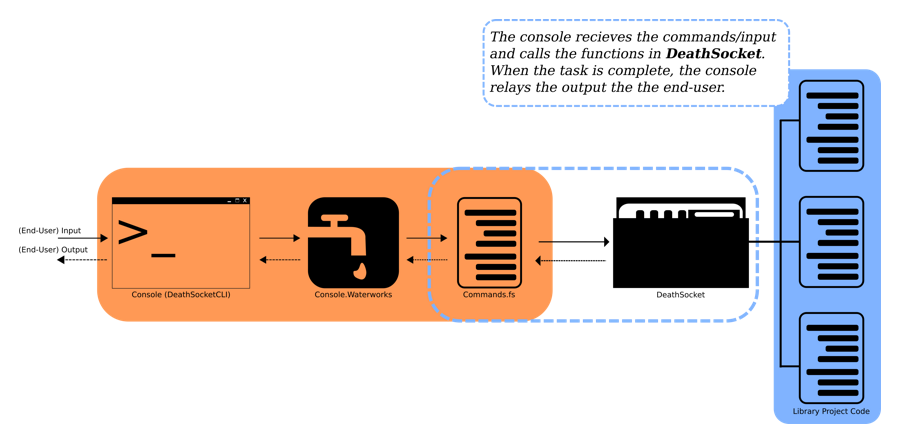To help you get up to speed on the way DeathSocketCLI works, please consider the following diagram.
The way it works is as follows:
- The console receives input from the end-user.
- The console parses the input, via the Console.Waterworks (C.W.) NuGet, and matches it with a "command-method" in "Commands.fs".
- The command-method executes its task -- by calling out to DeathSocket -- and returns its result to the console.
That's the simple version at least.
Note/Aside: "Command-method" is a term used within C.W. A "command-method" is a method which resides in the ConsoleCommands class (module in our case) and is accessible to the end-user at run-time. From a technical point-of-view, they are no different from a normal method/function. I am aware F# uses functions by default but I will continue to use "command-method". This is so I remain consistent with C.W's terminology. I know it's not great but it is what it is.
The reason the program runs this way is because I built it on top off C.W. I will not go into too much detail about how C.W. works here because it is out of scope for this wiki. Instead, I will provide links to its repository and wiki. Which are:
- Console.Waterworks Repository
- Console.Waterworks Wiki
- Console.Waterworks.Core Repository (This is the .Net Core version.)
- Console.Waterworks.Core Wiki (The .Net Core version operates the same way as the traditional .Net one. So, this wiki is not as comprehensive and mostly serves as a place to set-up the .Net Core version of C.W.)
At a basic level, C.W. is a NuGet package which helps you write console programs. From a distance, C.W. programs look a bit like Model-View-Controller (M.V.C.) programs. To help explain, here is a diagram of C.W's basic structure/flow.
For C.W. to operate the way it does, it needs to rely on certain things. Which are as follows:
- It controls the input-loop from within
main, in "Program.fs. - There is a
ConsoleCommandsmodule/ (C#) class within the project. - The
ConsoleCommandsmodule/(C#) class must live in a name-space. - The
ConsoleCommandsmodule/(C#) class is public. - The functions/(C#) methods the end-user can use at run-time are marked as
public,staticand live inConsoleCommands.
As an aside...
I wrote C.W. with C# and without F# in mind. (I did not know any F# at the time either.) Because of that, some of the code in DeathSocketCLI might look a little "off" -- as it is catering to some C# requirements. The most obvious one is the methods in ConsoleCommands must be static. This is something you should not notice because F# does not have an explicit notion of static methods in its modules -- like C#.
If you would like to know more about utilising C.W. in an F#-only context, head over to another repository of mine. Its name is Brittle Fish and it is a tutorial/reference repository for F# developers wanting to use C.W.. One of its main strengths is it points out potential pitfalls you might run into when using C.W. with F#. This is useful because C.W. makes no reservations for F#. So, knowing where and why you might need to alter your idiomatic F# code should help reduce bugs and frustration levels. The links for Brittle Fish are as follows:
End of aside.
When you start working with the code base, I recommend you stick to "ConsoleCommands.fs", "Programs.fs" and "Validation.fs". Although, that should quickly drop to "ConsoleCommands.fs" and "Validation.fs". This is because you will not need to work/alter anything in "Program.fs" when you understand what it is doing.
How the three files work together are as follows:
- The
mainfunction in "Program.fs" creates an input-loop at run-time. This allows the end-user to enter commands. - The input entered with the command is parsed and passed to the appropriate command-method in "Commands.fs".
- Because C.W. does not provide context-specific checks, the command-method passes the input to "Validation.fs".
- If the input is valid, the command-method proceeds and completes its task.
- When completed, the command-method returns a message to the console.
It is worth pointing out the Validation module provides "helper" functions alongside it validation ones. This is because the program, as a whole, is not that big. It seemed/seems pointless to "over-engineer" the solution. So, for now, some "helper" functions sitting next to validation functions is okay. Although, that means "Validation.fs" will need refactoring if the project's features grow in size/complexity.



